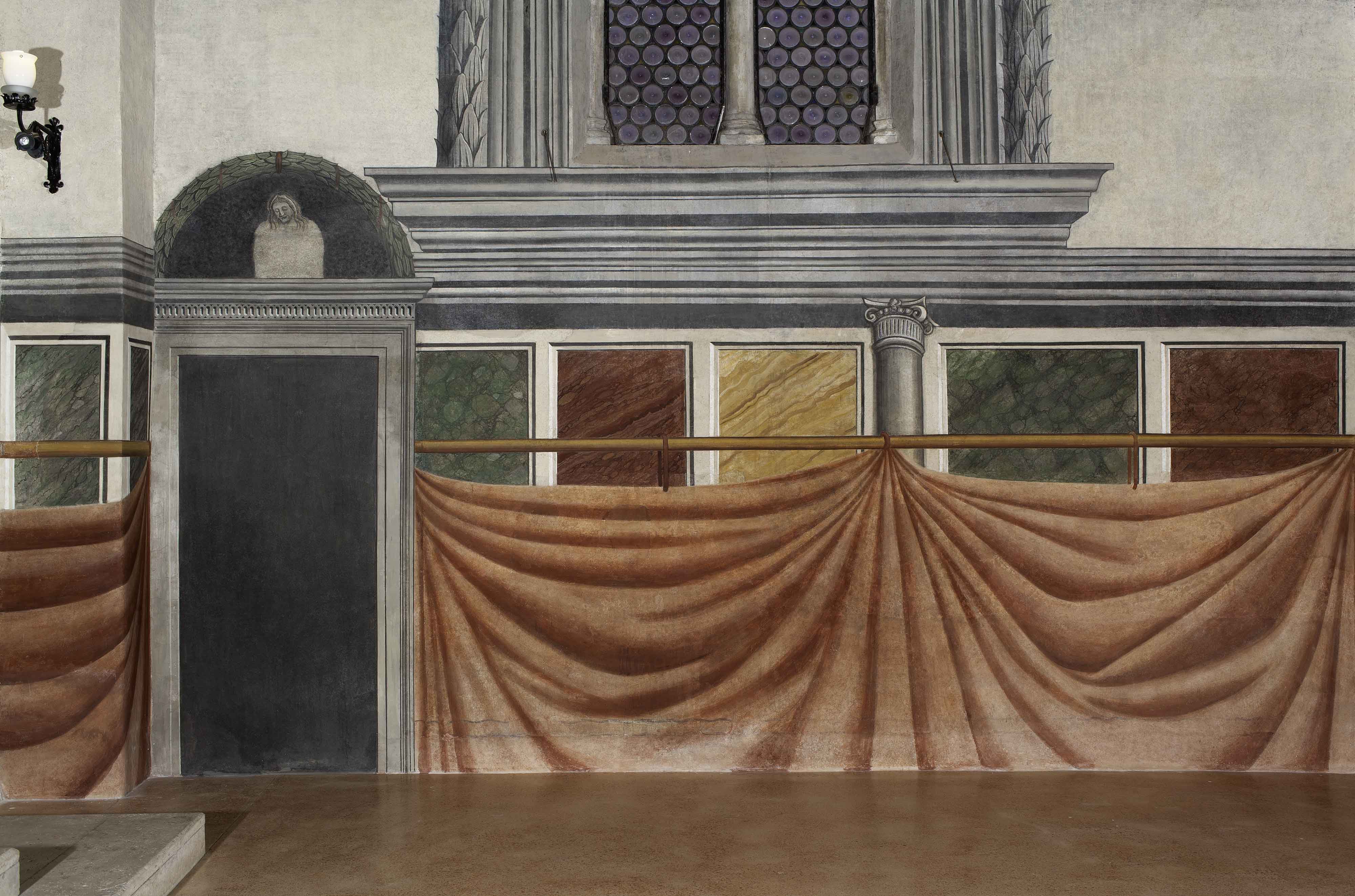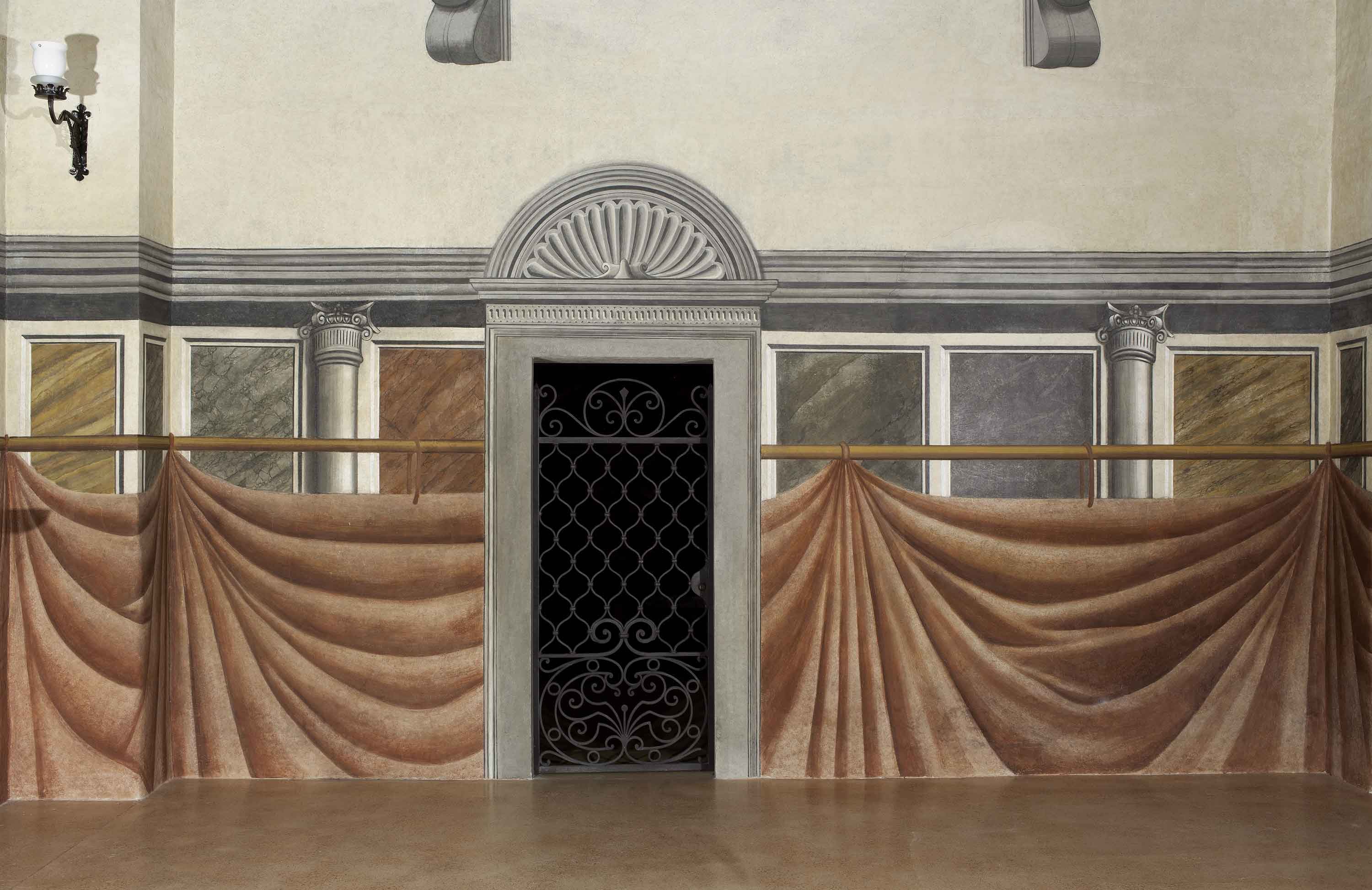Vatican City: Church of San Salvatore
Date: IX century
Materials: Paint on plaster, glass windows with wooden frames, stone
Adopted By: The Ohio Chapter
Total Cost: € 136,500
Description
The Church of St. Salvatore of Terrione, popularly known as “di Ossibus,” is near the Palace of the Holy Office a few meters from the southern arm of the Bernini portico of St. Peter’s. It marks the westernmost point of the Vatican City State.
Referred to in some historical documents as St. Salvatore of Ossibus due to confusion with a similarly named medieval church, this church was most properly called “of Terrione” after ruins near the present Roman Porta Cavalleggeri. The oldest names date from the pontificate of Leo IV (847-855). A decree from the pope names the church of St. Salvatore “in Terrione.” According to some studies the Scuola Francorum founded by Charlemagne, was attached. The Church appears again later in historical sources in both 1053 and 1186.
During the pontificate of Nicholas V (1447-1455), the church was restored but it is not known whether it was by the direct intervention of the pope or by another person, reported by Grimaldi in 1619 (Cod. Vatic. Barber. 2733, f. 326). The coat of arms of Nicholas V is painted inside the church, likely as testimony that he undertook this restoration. The interior frescoes are largely original and identifiable by the 15th-century insignias which bear the same stylistic characteristics as the frescoes.
In 1922-1923 Pope Pius XI (1922-1939) gave the grounds at Nero’s Circus to the Knights of Columbus so they could build the Oratory for St. Peter’s. Several buildings were destroyed during this time. The Church of St. Salvatore of Terrione, however, was saved and used as a chapel for the Oratory.
Between 1923 and 1924 the Knights of Columbus conducted restoration on the building. Among the works restored were stained glass windows that bear the insignia of the association.
The original work of the Middle Ages is no longer present. The small church appears clearly and three-dimensionally outlined for the first time in the perspective map of G.B. Falda of 1676. It successively appears in the Map of Rome of G.B. Nolli in 1748. A topographic map of the area of the Guida de Touring Club Italiano and a photograph in 1917 of the Photographic Archives in the Vatican Museums document the status of the building and its relationship with its surroundings around the beginning of the 20th century, before the restorations performed by the Knights of Columbus. Architectural forms, such as illusionary columns, are painted on the walls and are found in a limited number of documents from the early Renaissance period until about the middle of the 15th century.
The Vatican is conserving the environment of the Biblioteca Graeca (Greek Library) located on the ground level of the Palace of Nicholas V, in which the decoration was probably coeval to the 15th-century restoration of St. Salvatore of Terrione. The most recent studies of the frescoes in the library and the church propagate the authorship of these decorations to Andrea del Castagno.
The chapel now serves the community of the Missionaries of Charity, the order founded by Blessed Mother Theresa of Calcutta. The nuns hold daily prayer and adoration in this medieval chapel which connects to the corner buildings given them as a house for the poor. In the chapel of St. Salvatore they gain strength to joyfully serve the poorest of the poor with a soup kitchen that offers warm meals daily.
State of Preservation
All of the murals had evident salt deposits due to humidity and inclement weather over the centuries. Rainfall caused the roof to leak and problems with the roofing occurred. These problems have been solved, therefore the work of restoration commenced. Retouches of the paintings were particularly concentrated in the lower register of the walls made visible by damage all around the perimeter band. Without suitable scaffolding, it was not possible to determine the extent of the damage on the upper register and vaults, but the inspection conducted in February 2010 along the band and headroom revealed evidence of numerous areas where the plaster is peeling. The paintings appeared blurry on the surface, which can be attributed to dust sediments.
The recent restoration of the Chapel of San Pius V in the Palace of the Holy Office led to valuable experience which induced us to continue with this restoration from a comparable period. A similar type of restoration produced the same positive and notable results obtained.
Restoration Procedures
Restoration Process Includes:
For the Paintings:
- Re-adhesion and consolidation of plaster
- Restoration of pictorial film
- Cleaning of pictorial surfaces
- Filling in of gaps
- Reintegration and touching up of painting
- Chromatic adjustment of the decorative scores
- Restoration of marble
- Photographic documentation
For the Windows:
- Disassembly of panels
- Removal of old reinforcement bars and hooks
- Cleaning of all surfaces
- Cleaning of front and back with special solution
- Bonding of the weave using a suitable adhesive
- Replacement of the windows with windows of equal origins
- Consolidation and reintegration of frames
Detail
Adopted By:
The Ohio ChapterDate: IX century
Materials: Paint on plaster, glass windows with wooden frames, stone
Wishbook year: 2011
Total Cost
€ 136,500

Vatican City: Church of San Salvatore

Details
Adopted by: The Ohio Chapter
Date: IX century
Materials: Paint on plaster, glass windows with wooden frames, stone
Department: XV-XVI Century Art
Laboratory: Painting & Wood
Wishbook year: 2011
Description
The Church of St. Salvatore of Terrione, popularly known as “di Ossibus,” is near the Palace of the Holy Office a few meters from the southern arm of the Bernini portico of St. Peter’s. It marks the westernmost point of the Vatican City State.
Referred to in some historical documents as St. Salvatore of Ossibus due to confusion with a similarly named medieval church, this church was most properly called “of Terrione” after ruins near the present Roman Porta Cavalleggeri. The oldest names date from the pontificate of Leo IV (847-855). A decree from the pope names the church of St. Salvatore “in Terrione.” According to some studies the Scuola Francorum founded by Charlemagne, was attached. The Church appears again later in historical sources in both 1053 and 1186.
During the pontificate of Nicholas V (1447-1455), the church was restored but it is not known whether it was by the direct intervention of the pope or by another person, reported by Grimaldi in 1619 (Cod. Vatic. Barber. 2733, f. 326). The coat of arms of Nicholas V is painted inside the church, likely as testimony that he undertook this restoration. The interior frescoes are largely original and identifiable by the 15th-century insignias which bear the same stylistic characteristics as the frescoes.
In 1922-1923 Pope Pius XI (1922-1939) gave the grounds at Nero’s Circus to the Knights of Columbus so they could build the Oratory for St. Peter’s. Several buildings were destroyed during this time. The Church of St. Salvatore of Terrione, however, was saved and used as a chapel for the Oratory.
Between 1923 and 1924 the Knights of Columbus conducted restoration on the building. Among the works restored were stained glass windows that bear the insignia of the association.
The original work of the Middle Ages is no longer present. The small church appears clearly and three-dimensionally outlined for the first time in the perspective map of G.B. Falda of 1676. It successively appears in the Map of Rome of G.B. Nolli in 1748. A topographic map of the area of the Guida de Touring Club Italiano and a photograph in 1917 of the Photographic Archives in the Vatican Museums document the status of the building and its relationship with its surroundings around the beginning of the 20th century, before the restorations performed by the Knights of Columbus. Architectural forms, such as illusionary columns, are painted on the walls and are found in a limited number of documents from the early Renaissance period until about the middle of the 15th century.
The Vatican is conserving the environment of the Biblioteca Graeca (Greek Library) located on the ground level of the Palace of Nicholas V, in which the decoration was probably coeval to the 15th-century restoration of St. Salvatore of Terrione. The most recent studies of the frescoes in the library and the church propagate the authorship of these decorations to Andrea del Castagno.
The chapel now serves the community of the Missionaries of Charity, the order founded by Blessed Mother Theresa of Calcutta. The nuns hold daily prayer and adoration in this medieval chapel which connects to the corner buildings given them as a house for the poor. In the chapel of St. Salvatore they gain strength to joyfully serve the poorest of the poor with a soup kitchen that offers warm meals daily.
State of Preservation
All of the murals had evident salt deposits due to humidity and inclement weather over the centuries. Rainfall caused the roof to leak and problems with the roofing occurred. These problems have been solved, therefore the work of restoration commenced. Retouches of the paintings were particularly concentrated in the lower register of the walls made visible by damage all around the perimeter band. Without suitable scaffolding, it was not possible to determine the extent of the damage on the upper register and vaults, but the inspection conducted in February 2010 along the band and headroom revealed evidence of numerous areas where the plaster is peeling. The paintings appeared blurry on the surface, which can be attributed to dust sediments.
The recent restoration of the Chapel of San Pius V in the Palace of the Holy Office led to valuable experience which induced us to continue with this restoration from a comparable period. A similar type of restoration produced the same positive and notable results obtained.
Restoration Procedures
Restoration Process Includes:
For the Paintings:
- Re-adhesion and consolidation of plaster
- Restoration of pictorial film
- Cleaning of pictorial surfaces
- Filling in of gaps
- Reintegration and touching up of painting
- Chromatic adjustment of the decorative scores
- Restoration of marble
- Photographic documentation
For the Windows:
- Disassembly of panels
- Removal of old reinforcement bars and hooks
- Cleaning of all surfaces
- Cleaning of front and back with special solution
- Bonding of the weave using a suitable adhesive
- Replacement of the windows with windows of equal origins
- Consolidation and reintegration of frames
Media

Vatican City: Church of San Salvatore - wall

Vatican City: Church of San Salvatore

© 2025 Patrons of the Arts
in the Vatican Museums
Vatican Museums V-00120,
Vatican City State (Europe)
+39 0669864499
